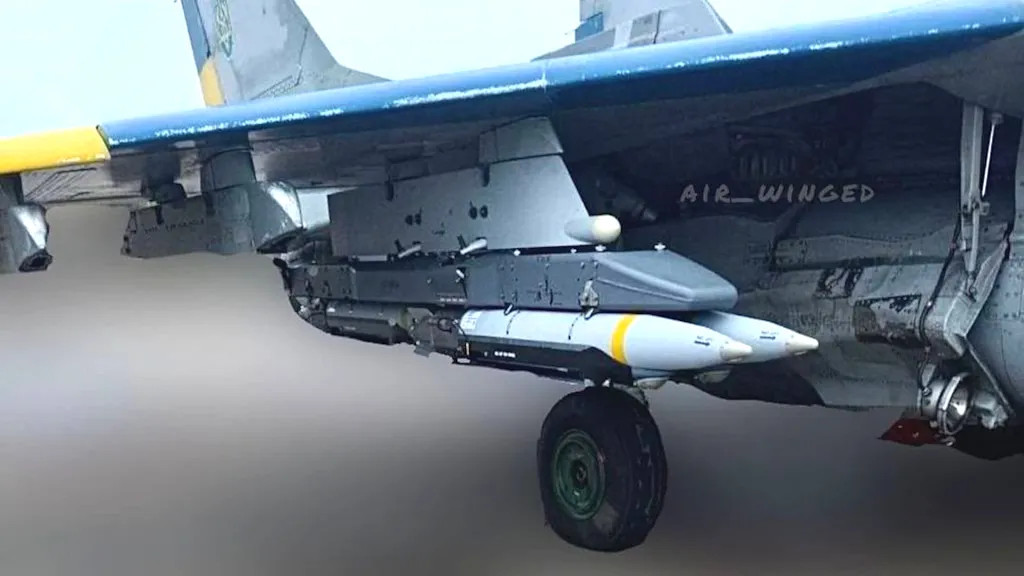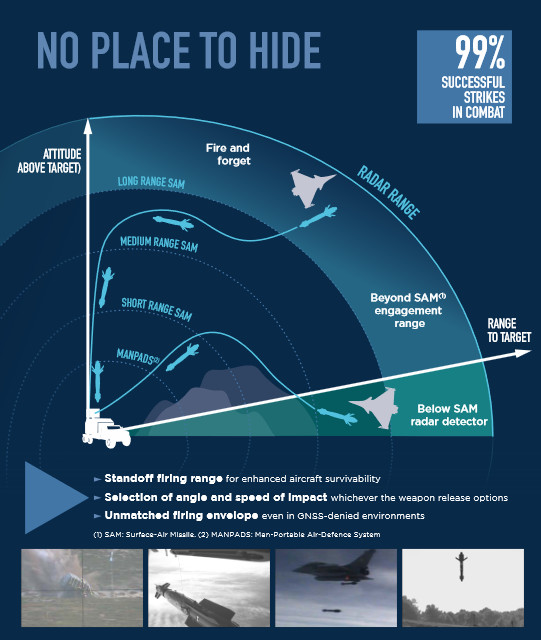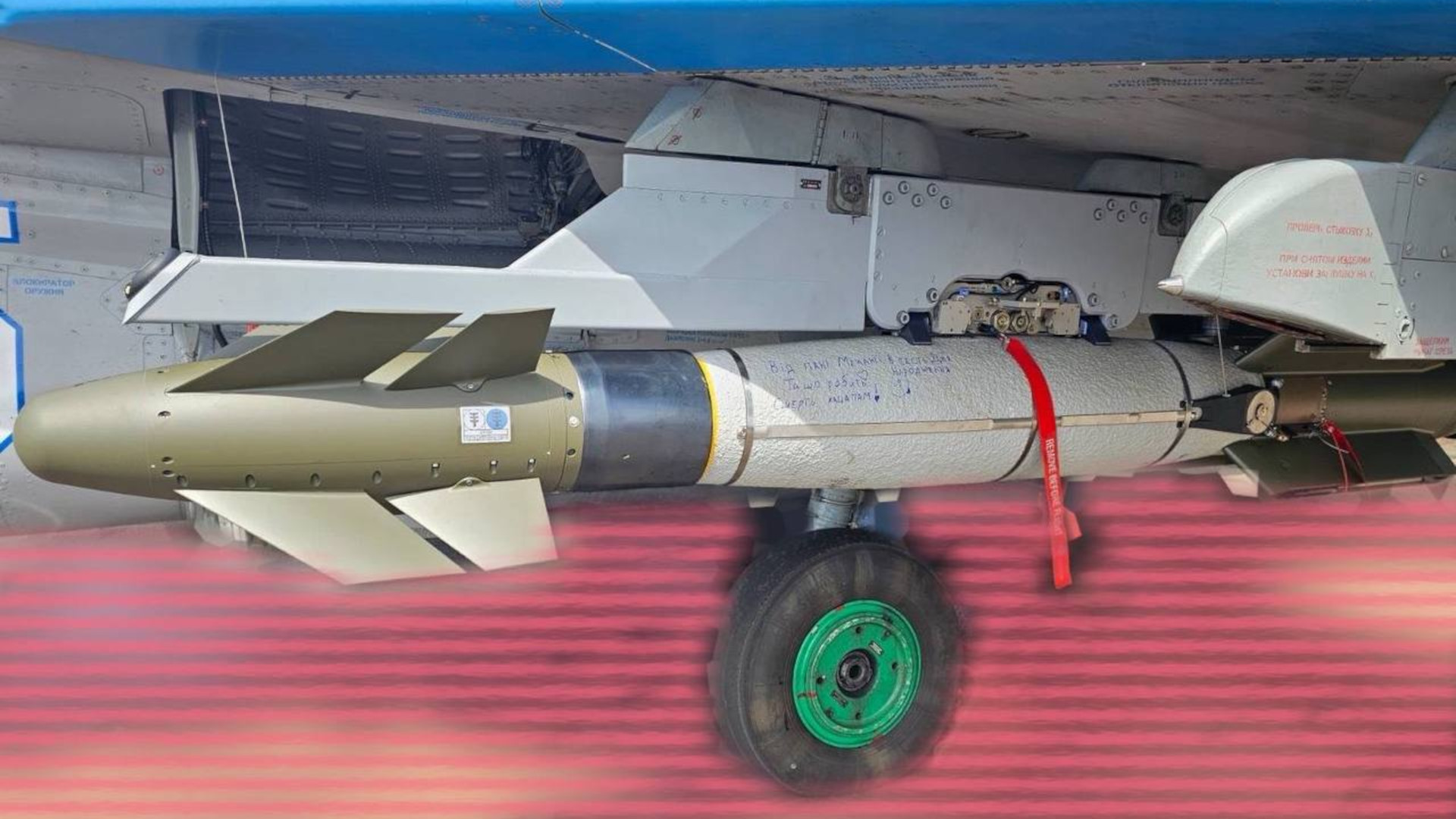The best look to date at a French-made AASM-250 Hammer under the wing of one of Ukraine’s MiG-29 Fulcrum fighters shows the rocket-boosted precision-guided bomb is employed with the help of a specialized pylon. The use of pylons with curious features to mate Western precision-guided munitions to Ukraine’s Soviet-era combat jets is a trend The War Zone has been following closely. The pylon the Hammer is hanging underneath has the same general form as one Ukrainian MiG-29s have been using together with U.S.-supplied JDAM-ER glide bombs that looks to be designed to help cue GPS-assisted guidance systems.
The new picture of the Hammer-armed MiG-29 showing the pylon, seen at the top of this story, first emerged on social media earlier today, but where or when it was taken is unknown. French authorities first announced that they would be sending AASM-250s to Ukraine in January. Ukrainian Fulcrums have since been observed carrying these munitions and imagery has previously emerged that might point to the country’s Su-27 Flankers employing them, as well. The Ukrainian Air Force has also said Hammer has been integrated onto its Su-25 Frogfoot ground attack jets.
Like the U.S. JDAM-ER, Hammer is more of a conversion kit for standard iron bombs of varying sizes, consisting of a guidance section that goes in front and a range-extension kit (REK) containing a rocket motor that goes at the tail end. The 500-pound/250-kilogram class AASM-250 versions that Ukraine has received can hit targets out to a range of at least 43 miles (70 kilometers), if not more, depending on the release envelope, according to the manufacturer Safran.

Safran offers multiple guidance options for Hammer, but the example seen in the newly emerged picture from Ukraine looks to have the baseline GPS-assisted inertial navigation system (INS) nose. The bomb used as the munition’s warhead also has a thermal protective coating designed to help delay it from cooking off in the event of a fire.
The pylon that the Hammer is hanging off of has a notable protrusion that extends forward of where the bomb is attached, which has a black-colored antenna at the tip. Overall, the pylon has the same general look as one previously seen on another Ukrainian MiG-29 with a JDAM-ER loaded onto it, which also had an extremely similar, if not identical feature installed at the end of a taper extension in front.


JDAM-ER also uses GPS-assisted INS guidance and The War Zone has posited in the past that the pylon design used with that munition is related to the need to cue it before release, writing previously:
“The JDAM-ER uses a GPS-assisted inertial navigation system (INS) guidance package to strike a fixed set of coordinates. Those coordinates can be preloaded onto the bomb on the ground or the pilot can program it in flight so long as the appropriate data linkages and user interfaces are present. How those coordinates are derived can vary.”
“What doesn’t change is the bomb’s need for locational data at the moment of launch to understand its relative position to the target. However, Ukraine’s MiG-29s and Su-27s do not have the kind of integrated GPS/INS capability and a NATO-compatible data bus that is needed for JDAM-ER. So, the fixture at the end of the pylon could be a GPS antenna that feeds key information into the bombs before they are released. Mounting it on the protrusion would help ensure it has a clear line of sight to the satellite constellation and is not shadowed by the aircraft’s wing structure.”
“All of this would provide a useful and self-contained workaround to help ensure that Ukrainian pilots can employ the JDAM-ER without severely degrading its capabilities and requiring any more complex integration work than is necessary. There is also the possibility that this unique arrangement may be a contributing factor in reports that Russian electronic warfare systems have been able to degrade the effectiveness of Ukrainian JDAM-ERs.”
To that latter point, Russia’s GPS jamming has reportedly had serious negative impacts on the effectiveness of other Western air and ground-launched precision munitions. In May, the U.S. Air Force announced that it was buying home-on-GPS-jam seekers to add to Ukraine’s JDAM-ERs to help address these threats.
All of this would also apply to Hammer and what would be necessary to integrate it onto Ukraine’s MiGs and Sukhois. It has also since emerged that the integration at least of U.S.-supplied precision-guided munitions on Ukrainian aircraft has involved the use of an ad-hoc control system that utilizes iPads or similar tablet-like devices installed in their cockpits, as can be seen in the video below. This further underscores the use of more self-contained architectures to get around the limitations imposed by the Soviet-era designs.
There is still the possibility that the black-colored feature at the end of the Hammer pylon is tied to another add-on capability, such as an electronic countermeasures system. However, this seems less likely especially now that this same general design has been observed in combination with two different GPS/INS-guided munitions.
Last month, a picture emerged showing another mysterious pylon under the wing of another Ukrainian MiG-29 with a white-colored antenna or sensor at the front that could be part of an electronic countermeasures system. That pylon was used to attach GBU-39/B Small Diameter Bombs (SDB) loaded on a four-bomb BRU-61/A rack to the aircraft. SDBs also use GPS-assisted INS guidance, but the white fixture seen on the pylon in that instance is positioned more underneath the wing. This would seem less optimal for cueing purposes, where a good line of sight to satellites in space is required.

As an aside here, it is interesting to note that the initial tranche of F-16AM Vipers that Ukraine just recently received includes examples with pylons with integrated missile warning sensors and countermeasures dispensers, as you can read more about here. However, the U.S.-made fighters do not need specialized pylons like the ones seen on Ukrainian jets and can take better advantage of U.S.-supplied precision-guided munitions that Ukraine has already gotten, like the aforementioned JDAM-ER and SDB, thanks to their NATO-standard bus architecture. The Vipers can also be used as launch platforms for AGM-88 High-speed Anti-Radiation Missiles (HARM) and ADM-160 Miniature Air-Launched Decoys (MALD) the Ukrainian Air Force has received from the United States. The NATO-standard systems will make it easier to add other U.S. precision munitions, and potentially other Western types like Hammer, to the arsenals of those jets going forward, as well.
So far, Ukraine’s new F-16s have been seen with air-to-air focused loadouts consisting of AIM-120 Advanced Medium-Range Air-to-Air missiles (AMRAAM) and AIM-9L/M Sidewinders. AIM-120s and AIM-9s have already been in Ukraine’s inventory for some time now, but for use as surface-to-air interceptors.
However Ukrainian aircraft continue to employ the French-supplied Hammers, those munitions have given the country important new options for conducting precision strikes beyond the front lines while reducing the risks to the launch platforms. The maximum ranges of the Hammer and the JDAM-ER are roughly the same and both bombs need to be released at higher altitudes to get the most reach.
However, Safran says that Hammer, thanks to its rocket booster, can still hit targets at least nine miles (15 kilometers) away even when released at very low altitudes where the aircraft employing it can better hide from enemy air defenses. The AASM-250’s flight profile means that it can also be lobbed over terrain, further helping to shield the launch platform from hostile threats. Hammer impacts with a higher-energy state than its glide bomb counterparts giving it that much more capability to punch into harder targets.

Not surprisingly, we have already seen evidence of Ukrainian MiG-29s employing Hammers using low-altitude toss-bombing techniques that make good use of the munition’s unique design. Unpowered JDAM-ERs can be employed in this way to extend their reach when released at low altitudes, but to a lesser degree.
The newly emerged picture of the Hammer on the special pylon underneath the wing of one of Ukraine’s Fulcrums adds to the growing insights into how this and other important Western precision strike capabilities have been added to the arsenals of the country’s Soviet-era jets.
Contact the author: joe@twz.com
